A Spicy Affair — A Harissa Summer Recipe
Harissa is truly the perfect condiment. Use it to enhance meat and fish dishes or as a marinade for chicken thighs and breast. My personal favorite way to eat harissa is with a grilled steak.

Soon after Alan and I announced our engagement, a keg of beer was delivered to his doorstep. Alan called his sister-in-law Ingrid in London and they laughed over the phone. She had remembered their long held wager — she bet that he would land up with a South African girl, he was adamant that he would not. My South African accent is rather good … but I’m not South African.
We planned an engagement party. Alan’s parents flew in from San Francisco and his sister Brigitte and brother-in-law Michael traveled from St Louis. But Ingrid and Larry may have had the last laugh when they surprised Alan by also landing on our doorstep from London.
We served the beer at our engagement party.
Then it was time to set a wedding date. Alan’s sister (a doctor) told us the wedding couldn’t be in June because of her hospital rotation. We were left with very limited options because of the three weeks (Jews don’t have celebrations between the 17th of Tammuz and the 9th of Av, a time of mourning).
The date we chose for our wedding was July 3rd. That year, the Hebrew date was Yud Bet Tammuz, an auspicious day on the Chabad Lubavitch calendar. It marks the day in 1927 that the previous Rebbe, who had been sentenced to death, was miraculously freed from Soviet imprisonment and became known as the Frierdiker Rebbe. Soon after, the headquarters of Lubavitch were moved to Latvia, then Warsaw, Poland. In 1940, with the lobbying of many Jewish leaders and help from the US State Department, Rav Yosef Yitzchak Schneersohn, his wife, his mother, his daughter Chana, son in law Rabbi Gurary and grandson reluctantly fled Nazi-occupied Poland.
When he arrived in New York, two of his chassidim came to him and advised him not to start the activities that Lubavitch had been involved in Europe. “America is different,” they said. He said that out of his eyes came “boiling tears.” The next day he started the first Lubavitcher Yeshiva in America, declaring “America is no different.”
In my mind, our wedding has always been tied to this wonderful piece of history. Whenever Alan and I travel to New York, we always stop at the Ohel, the resting place of the Frierdiker Rebbe and the Lubavitcher Rebbe.
As immigrants from other lands, Rachel and I both appreciate the gift of America. We both love celebrating American holidays. There’s symmetry in the fact that Neil and Rachel married the day before Thanksgiving and Alan and I the day before the 4th of July. That I threw a Thanksgiving Sheva Bracha for Neil and Rachel and Rachel threw a July 4th Sheva Bracha barbecue for Alan and I.
Grilling food on fire is primal. When done right, it’s also perfection. Served with Rachel’s trademark homemade harissa and some of the regular fixin’s, the steaks were truly melt-in-your-mouth delicious.
Grilling food on fire is primal. When done right, it’s also perfection. This Sunday, Rachel and I grilled some pasture raised bison from a kosher ranch in South Dakota. L’Chaim Meats is a husband and wife operation with the commitment to allow their bison to run free to ensure a healthy product. Served with Rachel’s trademark homemade harissa and some of the regular fixin’s, the steaks were truly melt-in-your-mouth delicious.
Happy 4th of July (and happy anniversary to my wonderful husband Alan)!
—Sharon
I have fallen in love with Harissa.
In the past, I would buy harissa at my local kosher market and use it in my Friday night Moroccan fish. But I never really paid too much attention to it.
My family is Spanish Moroccan and the foods we ate had more of a Sephardic influence rather than an Arabic flavor. I did not grow up eating harissa. Our brush with spicy food came when we would occasionally eat sausages called Merguez. A North African delicacy, merguez are usually made from lamb mixed with harissa. My most vivid memory from Morocco was the treat of a baguette stuffed with red hot, spicy merguez and French fries from the kosher sausage vendor. So good!
During the period of Spanish colonization, red peppers were imported from Mexico to Tunisia and chili peppers have been cultivated there since the mid-sixteenth century. The name harissa comes from the Arabic word that means “to crush, to grind or to puree.” The condiment is made by blending strong red peppers, garlic and olive oil and depending on which region of North Africa, various spices are added, like cumin, coriander or caraway.
My son Sam is a private chef (Sheff At Home) and he would make his own batch of harissa whenever he was cooking for his clients and would always bring me a jar. It was so much better than anything store bought.
This encouraged me to attempt my own version of harissa. Sam walked me through the steps, then left me to figure it out. Just like everything else you do in the kitchen, you have to taste, taste, taste, until that moment that you get it right.
The first taste was awful. Puréed peppers and garlic. So I started adding more oil and more salt. I decided it needed acid and threw in some vinegar. I finally achieved that deep pungent taste.
As a personal note of caution, wear gloves when making harissa so you don’t stain your nails and especially avoid rubbing your eyes. Avoid spills—once I dropped an open jar of harissa on my brand new white sneakers and I had to throw them in the trash.
Harissa is truly the perfect condiment. Use it to enhance meat and fish dishes or as a marinade for chicken thighs and breast. Add it to ground beef patties and grill them to make kofte kebab. Or add it to mayonnaise to make an aioli that’s great in sandwiches or salads.
My personal favorite way to eat harissa is with a grilled steak.
I hope you try this easy recipe and use harissa in your dishes this Fourth of July!
—Rachel
Harissa Recipe

Harissa is very adaptable, so you can use any combination of dried peppers. In California we have access to the best Mexican chiles, with every flavor profile, from fiery hot to smoky and sweet. I prefer to keep my harissa mild, adding cayenne pepper at the end to set the heat level.
If you love the heat, use one or two chiles de Arbol. For this recipe I use dried guajillo peppers which are very mild with a lot of depth and ancho for that classic smoky, sweet flavor.
-Rachel
2 dried ancho chile
1 tsp cumin seed or ground cumin
1 tsp caraway seeds or ground caraway
2 garlic cloves
1/4 cup red wine vinegar
3 Tbsp tomato paste
1 tsp cayenne pepper
2 tsp kosher salt
3/4 cup olive oil, divided
Step 1
Place chiles in a large heatproof glass bowl. Pour boiling water over the chiles, then cover with plastic wrap, or a heavy plate.
Set aside for 15-20 minutes, until the chiles are very pliable and are cool enough to handle.
Drain the water. Remove the stems and seeds and discard (wear gloves for this part).
Step 2
Toast the cumin and caraway in a dry small skillet over medium-low heat, tossing constantly, until very fragrant, about 3 minutes. (If you don’t have seeds, ground cumin and coriander can be used. ) Transfer to a food processor, add garlic, and pulse until spices and garlic are broken up .
Add the chiles and pulse until mixture forms a coarse paste. Add the vinegar, tomato paste, cayenne pepper and salt and process until the mixture is mostly smooth but retains a little texture. With the motor running, stream in ½ cup of olive oil. Process until the oil is incorporated.
Step 3
Transfer the harissa to a bowl or glass container. Pour remaining ¼ cup oil over top.
Cover tightly and chill.
Note:
Harissa can be stored in the refrigerator for 1 month.
Sharon Gomperts and Rachel Emquies Sheff have been friends since high school. The Sephardic Spice Girls project has grown from their collaboration on events for the Sephardic Educational Center in Jerusalem. Follow them
on Instagram @sephardicspicegirls and on Facebook at Sephardic Spice SEC Food.







